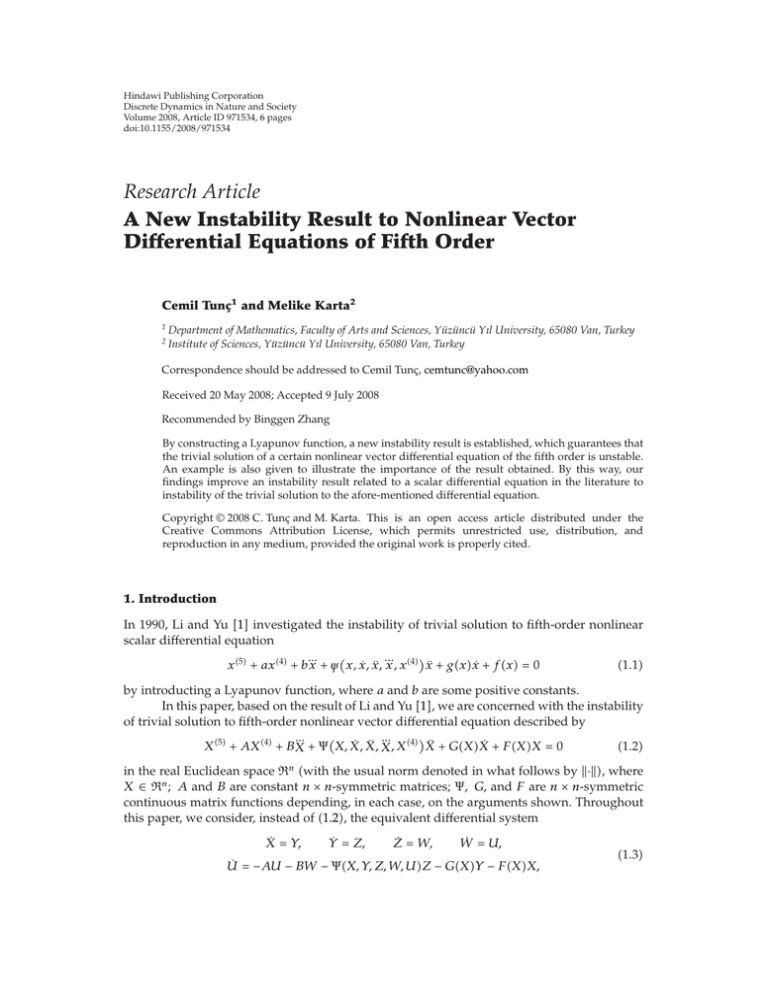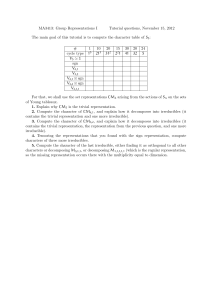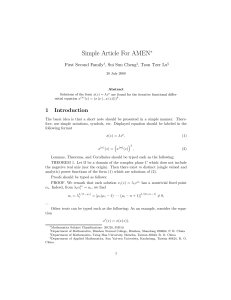Hindawi Publishing Corporation Discrete Dynamics in Nature and Society pages
advertisement

Hindawi Publishing Corporation Discrete Dynamics in Nature and Society Volume 2008, Article ID 971534, 6 pages doi:10.1155/2008/971534 Research Article A New Instability Result to Nonlinear Vector Differential Equations of Fifth Order Cemil Tunç1 and Melike Karta2 1 2 Department of Mathematics, Faculty of Arts and Sciences, Yüzüncü Yıl University, 65080 Van, Turkey Institute of Sciences, Yüzüncü Yıl University, 65080 Van, Turkey Correspondence should be addressed to Cemil Tunç, cemtunc@yahoo.com Received 20 May 2008; Accepted 9 July 2008 Recommended by Binggen Zhang By constructing a Lyapunov function, a new instability result is established, which guarantees that the trivial solution of a certain nonlinear vector differential equation of the fifth order is unstable. An example is also given to illustrate the importance of the result obtained. By this way, our findings improve an instability result related to a scalar differential equation in the literature to instability of the trivial solution to the afore-mentioned differential equation. Copyright q 2008 C. Tunç and M. Karta. This is an open access article distributed under the Creative Commons Attribution License, which permits unrestricted use, distribution, and reproduction in any medium, provided the original work is properly cited. 1. Introduction In 1990, Li and Yu 1 investigated the instability of trivial solution to fifth-order nonlinear scalar differential equation ... ... x5 ax4 b x ψ x, ẋ, ẍ, x, x4 ẍ gxẋ fx 0 1.1 by introducting a Lyapunov function, where a and b are some positive constants. In this paper, based on the result of Li and Yu 1, we are concerned with the instability of trivial solution to fifth-order nonlinear vector differential equation described by ... ... 1.2 X 5 AX 4 BX Ψ X, Ẋ, Ẍ, X , X 4 Ẍ GXẊ FXX 0 in the real Euclidean space Rn with the usual norm denoted in what follows by ·, where X ∈ Rn ; A and B are constant n × n-symmetric matrices; Ψ, G, and F are n × n-symmetric continuous matrix functions depending, in each case, on the arguments shown. Throughout this paper, we consider, instead of 1.2, the equivalent differential system Ẋ Y, Ẏ Z, Ż W, Ẇ U, U̇ −AU − BW − ΨX, Y, Z, W, UZ − GXY − FXX, 1.3 2 Discrete Dynamics in Nature and Society ... which was obtained as usual by setting Ẋ Y, Ẍ Z, X W, X 4 U from 1.2. For the sake of brevity, we assume that the symbol JG X denotes the Jacobian matrix JG X ∂gi ∂xj i, j 1, 2, . . . , n, 1.4 where x1 , x2 , . . . , xn and g1 , g2 , . . . , gn are components of X and G, respectively. In addition, it is assumed, as basic throughout the paper, that the Jacobian matrix JG X exists and is continuous and symmetric. The symbol X, Y corresponding to any pair X, Y in Rn stands for the usual scalar product ni1 xi yi , and λi A, A aij i, j 1, 2, . . . , n are the eigenvalues of the n × n-symmetric matrix A, and the matrix A aij is said to be positive definite if and only if the quadratic form X T AX is positive definite, where X ∈ Rn and X T denotes the transpose of X. At the same time, up to now, we should also recognize that some significant theoretical results related to instability of trivial solution of some nonlinear scalar and vector differential equations of fifth order have been achieved in the literature, see, for example, the papers of Ezeilo 2, 3, Tunç 4, 5, and the references registered in these papers. However, it should be noted that nearly all of the papers have been published on the subject without including any example related to the topic. The equation considered that the assumptions and Lyapunov 6 function that will be established here are completely different than those mentioned in the literature. 2. Main result Our main result is the following theorem. Theorem 2.1. In addition to the basic assumptions imposed on A, B, Ψ, G, and F appearing in 1.2, we assume there are constants a, b and a positive constant k1 such that the following conditions hold: i λi A ≥ a, λi B ≥ b, b sgn a > 0; ii λi FXsgn a − 1/4|a|λi ΨX, Y, Z, W, U2 > k1 i 1, 2, . . . , n. Then the trivial solution X 0 of 1.2 is unstable. Now, in order to prove our main result, we give a well-known lemma which plays an essential role throughout the proof of theorem. Remark 2.2. It should be noted that there is no restriction on symmetric matrix G appearing in 1.2. Lemma 2.3. Let A be a real symmetric n × n-matrix and a ≥ λi A ≥ a > 0 i 1, 2, . . . , n, 2.1 where a , a are constants. Then a X, X ≥ AX, X ≥ aX, X, a2 X, X ≥ AX, AX ≥ a2 X, X. 2.2 C. Tunç and M. Karta 3 Proof. See 7. Proof of Theorem 2.1. To achieve the proof of theorem, we define the following Lyapunov function V : V X, Y, Z, W, U: V V0 X, Y, Z, W, Usgn a, 2.3 V0 Y, W Y, AZ − X, U − X, AW − X, BZ 1 1 1 − Z, Z BY, Y − σGσXX, X dσ. 2 2 0 2.4 where Now, under the assumptions of the theorem, it will be shown that the Lyapunov function V V X, Y, Z, W, U satisfies the entire Krasovskiı̆ 8 criteria. K1 In every neighborhood of 0, 0, 0, 0, 0, there exists a point ξ, η, ζ, μ, ρ such that V ξ, η, ζ, μ, ρ > 0. K2 The time derivative V̇ d/dtV X, Y, Z, W, U along solution paths of system 1.3 is positive semidefinite. K3 The only solution X, Y, Z, W, U Xt, Y t, Zt, Wt, Ut of system 1.3 which satisfies V̇ 0 t ≥ 0 is the trivial solution 0, 0, 0, 0, 0. These properties guarantee that the trivial solution of 1.2 is unstable. First, it is easy to see from 2.3 and 2.4 that V 0, 0, 0, 0, 0 V0 0, 0, 0, 0, 0sgn a 0. 2.5 Next, evidently, one can easily get 1 1 V 0, ε sgn a, 0, ε, 0 ε, ε b sgn aε, ε ε2 b sgn aε2 > 0 2 2 2.6 for all arbitrary ε / 0, ε ∈ Rn . Finally, let X, Y, Z, W, U Xt, Y t, Zt, Wt, Ut be an arbitrary solution of system 1.3. Differentiating 2.4 with respect to t, along this solution, calculations give that V̇0 d V0 X, Y, Z, W, U AZ, Z FXX, X X, ΨX, Y, Z, W, UZ dt d 1 GXY, X − σGσXX, X dσ. dt 0 2.7 Now, recall that d dt 1 0 σGσXX, X dσ 1 σGσXY, X dσ 1 ∂ σGσXY, X dσ 0 0 ∂σ 1 σ 2 GσXY, X 0 GXY, X . σ 2.8 Substituting 2.8 into 2.7, we obtain V̇0 AZ, Z FXX, X X, ΨX, Y, Z, W, UZ . 2.9 4 Discrete Dynamics in Nature and Society Now, it follows from 2.3 and 2.9 that V̇ sgn aZ, AZ sgn a X, FXX sgn a X, ΨX, Y, Z, W, UZ ≥ |a|Z, Z sgn a X, FXX sgn a X, ΨX, Y, Z, W, UZ 2 1 Z ΨX, Y, Z, W, W, UX sgn a |a| 2|a| 1 sgn a X, FXX − ΨX, Y, Z, W, UX, ΨX, Y, Z, W, UX 4|a| 1 ≥ sgn a X, FXX − ΨX, Y, Z, W, UX, ΨX, Y, Z, W, UX 4|a| 2.10 ≥ k1 X2 ≥ 0, by i and ii. Thus, the assumptions of theorem show that V̇ t ≥ 0 for all t ≥ 0, that is, V̇ is positive semidefinite. Furthermore, V̇ 0 t ≥ 0 necessarily implies that X 0 for all t ≥ 0, and ... Z Ẏ 0, W Ÿ 0, Ẇ Y 0 for all t ≥ 0. Thus, it follows the estimates X Y Z W U 0. 2.11 Therefore, the function V has the entire criteria of Krasovskiı̆ 8 if the assumptions of theorem hold. Thus, the basic properties of the function V X, Y, Z, W, U, which are proved above, verify that the trivial solution of system 1.3 is unstable. The system of 1.3 is equivalent to the differential equation 1.2. Hence, this fact completes the proof of theorem. Example 2.4. As special cases of system 1.3, let us choose for n 2, A, B, Ψ, and F: A 3 1 1 3 , B 4 2 2 4 , ⎤ ⎡ −1 1 2 1 x2 y2 z2 w2 u2 ΨX, Y, Z, W, U ⎣ −1 ⎦ , 1 2 1 x2 y2 z2 w2 u2 ⎡ ⎤ 1 20 1 ⎢ ⎥ 1 x2 ⎥. FX ⎢ ⎣ 1 ⎦ 1 20 1 x2 2.12 C. Tunç and M. Karta 5 Then, respectively, we get λ1 A 2, λ2 A 4, λ1 B 2, λ2 B 6, λ1 ΨX, Y, Z, W, U 1 1 , 1 x2 y2 z2 w2 u2 λ2 ΨX, Y, Z, W, U 3 1 , 1 x2 y2 z2 w2 u2 2.13 λi ΨX, Y, Z, W, U ≥ 1, λ1 FX 19 1 , 1 x2 λ2 FX 21 1 . 1 x2 Now, taking into account this facts, it can be easily seen that λi A ≥ 2 a, 19 19 21 21 λi B ≥ 2 b, 1 1 x2 1 1 x2 1 1 x2 1 1 x2 λi FX sgn ≥ 19 sgn 2 − 2 1 1 1 > 0, 8 1 x2 y2 z2 w2 u2 sgn 2 − 2 1 1 3 > 0, 8 1 x2 y2 z2 w2 u2 sgn 2 − 2 1 1 1 > 0, 8 1 x2 y2 z2 w2 u2 b sgn a > 0, 2 1 1 3 > 0. sgn 2 − 8 1 x2 y2 z2 w2 u2 i 1, 2, 2.14 Clearly, these last four expressions imply that 2 1 λi FX sgn a − λi ΨX, Y, Z, W, U > 0 i 1, 2. 4|a| 2.15 Thus, it is shown that all the assumptions of the theorem hold. References 1 W. J. Li and Y. H. Yu, “Instability theorems for some fourth-order and fifth-order differential equations,” Journal of Xinjiang University. Natural Science, vol. 7, no. 2, pp. 7–10, 1990 Chinese. 2 J. O. C. Ezeilo, “Instability theorems for certain fifth-order differential equations,” Mathematical Proceedings of the Cambridge Philosophical Society, vol. 84, no. 2, pp. 343–350, 1978. 3 J. O. C. Ezeilo, “A further instability theorem for a certain fifth-order differential equation,” Mathematical Proceedings of the Cambridge Philosophical Society, vol. 86, no. 3, pp. 491–493, 1979. 4 C. Tunç, “On the instability of solutions of certain nonlinear vector differential equations of fifth order,” PanAmerican Mathematical Journal, vol. 14, no. 4, pp. 25–30, 2004. 5 C. Tunç, “Further results on the instability of solutions of certain nonlinear vector differential equations of fifth order,” Applied Mathematics & Information Sciences, vol. 2, no. 1, pp. 51–60, 2008. 6 Discrete Dynamics in Nature and Society 6 A. M. Lyapunov, Stability of Motion, Academic Press, New York, NY, USA, 1966. 7 R. A. Horn and C. R. Johnson, Topics in Matrix Analysis, Cambridge University Press, Cambridge, UK, 1994. 8 N. N. Krasovskiı̆, “On conditions of inversion of A. M. Lyapunov’s theorems on instability for stationary systems of differential equations,” Doklady Akademii Nauk SSSR, vol. 101, pp. 17–20, 1955 Russian.






